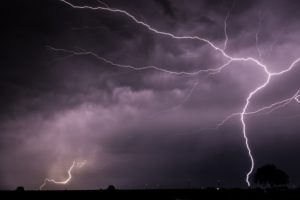
Find air purification that have the blue butterfly tick of approval:
Factsheet
Thunderstorm Asthma
If you’re allergic to grass pollens or have springtime hay fever, you should be using your asthma preventer before the ‘pollen season’ starts each year, and keep using it until pollen levels go down again. Most adults with asthma need to use a preventer all year, not just in springtime.
What is thunderstorm asthma?
Thunderstorm asthma is an asthma attack in someone who is allergic to grass pollen, caused by breathing outdoor air just before a storm. Even people without asthma can have thunderstorm asthma.
Spring thunderstorm weather can cause pollen grains to burst into tiny pieces and the wind then blows them around us. When people with pollen allergy breathe in these tiny pieces of pollen they can get deep inside the lungs and trigger an asthma attack.
It can happen suddenly to people in spring or summer when there is a lot of pollen in the air and the weather windy and stormy.
If you get hay fever in springtime, you could be at risk of thunderstorm asthma.
What you can do
People with asthma who are allergic to grass pollen or havespringtime hay fever need extra protection to avoid thunderstorm asthma. This means using a preventer, starting at least 2 weeks beforepollen levels are high.Pollen season is usually from September to the end of December in Victoria but can be earlier in New South Wales and Queensland.
People with asthma should always have a reliever inhaler ready.
See your doctor to get the best asthma treatment plan for you.
November 2016: Victorian Thunderstorm Asthma Event
On Monday 21 November 2016, severe thunderstorm activity in Victoria led to thousands of people suddenly having asthma attacks and finding it hard to breathe. Because so many people needed urgent asthma treatment at one time, it was hard for ambulance and hospital emergency rooms to help everyone.
From that terrible event we learned that thunderstorm asthma can affect people living in city or country areas, even if they’ve never had asthma. People with springtime hay fever were most likely to have thunderstorm asthma symptoms.
We also learned that some groups of people with grass pollen allergy are more likely to have a very severe thunderstorm asthma attack
People more likely to get thunderstorm asthma
- people who react strongly to grass pollen, like people with severe springtime hay fever
- people with asthma who have not been using their preventer
Common symptoms of asthma
- Wheezing – a whistling sound coming from the chest while you are breathing
- Breathlessness
- A feeling of tightness in the chest
- A persistent cough
Asthma symptoms can be different for different people.
A person’s asthma symptoms can also change – sometimes there are no symptoms, like when our asthma is well controlled by preventer medication or when allergy triggers aren’t around.
Common symptoms of seasonal hay fever
- Runny nose
- Itchy nose
- Sneezing
- Itchy, watery eyes
People with asthma be aware
If you have asthma and pollen allergy, you could have a severe asthma attack if you are outside in gusty wind during a springtime thunderstorm in a place where there is ryegrass pollen in the air (most of south-eastern Australia).
How do I know if I’m allergic to ryegrass pollen without having allergy tests?
If you get asthma or hay fever symptoms more often in spring, then pollen is probably causing your symptoms. If you’re not sure, follow the safety steps anyway.
What you can do to keep safe
- Always use your preventer medication as much as the doctor advised. Even if you do not normally use a preventer all year, you should use it throughout the pollen season if you are going to be in an area where there is ryegrass pollen (in Victoria, this means 1 September to 31 December).
- Always carry your reliever inhaler too.
- Keep up to date with pollen counts and weather forecasts during spring and early summer so you know if a storm is coming.
- Make sure your written asthma action plan is up to date and includes thunderstorm advice – talk to you doctor.
- Avoid being outdoors just before and during thunderstorms, especially in wind gusts before the rain. Get inside a building or car with the windows shut and the air conditioner switched to recirculate/ recycled.
People with springtime hay fever be aware
If you have springtime hay fever, you could suddenly get an asthma attack if you are outside in gusty wind during a spring thunderstorm in a place where there is a very high level of ryegrass pollen in the air (most of south-eastern Australia). This can happen even if you don’t have asthma.
What you can do
- Stay up to date with pollen counts and weather forecasts during spring and early summer so you know if a storm is coming
- Just before and during storms with wind gusts, get inside a building or car with the windows shut and the air conditioner switched to recirculate/recycled
- If you have breathing problems or think you may be having an asthma attack, ask your pharmacist for advice and see your doctor as soon as you can
Allergic rhinitis (hay fever) treatment
Effective treatments are available for people with allergic rhinitis. These include nasal sprays (like Avamys, Azonaire, Beconase, Budamax, Budesonide, Dymista, Flixonase, Nasonex, Omnaris, Rhinocort, Sensease, Telnase).
Talk to your doctor about which treatment is best for you


